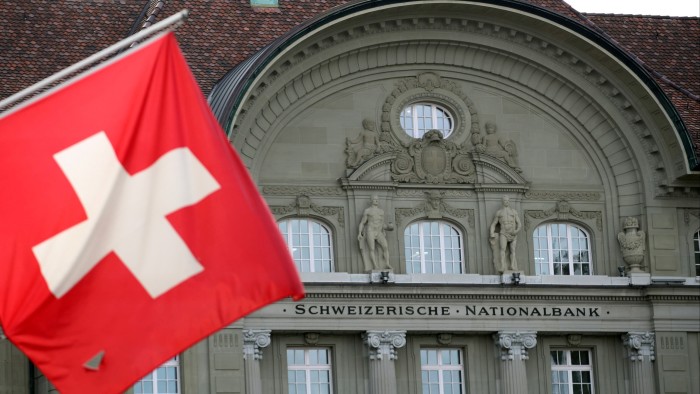The Swiss franc has soared to a decade high against the dollar as investors rush for shelter from the global trade turmoil, sparking bets that the country’s central bank will have to lower interest rates to zero or below to curb the currency’s rise.
The currency, historically a financial market haven because of the Alpine country’s political and economic stability, reached near-record strength against the dollar this week, with the greenback sinking close to SFr0.80 for the first time since the franc’s shock appreciation in 2015.
That has put policymakers in a bind, as they seek to restrain the currency to support the export-heavy economy without provoking a backlash from the US, which has already threatened Switzerland with high tariffs.
Those “cross-currents” put the central bank in a “staggeringly difficult” position, said Kit Juckes, chief FX strategist at Société Générale.
“The Swiss government doesn’t want major disinflationary pressures coming at it again, and so they’re frustrated,” he added.
Yields on short-term government debt have dipped into negative territory in recent days as traders bet that the Swiss National Bank will respond with interest rate cuts. Two-year Swiss yields, which reflect expectations for interest rates, traded marginally below zero on Friday.

The rapid appreciation in the franc risks a deflationary shock for Switzerland, say analysts, exacerbated by the growth impact of US President Donald Trump’s trade war.
At 31 per cent, the “reciprocal” tariffs placed on Swiss goods earlier this month — before being suspended for 90 days — exceed the levies on the EU. Switzerland relies on US consumers for more than 10 per cent of exports.
The situation has propelled the government into a diplomatic offensive.
Swiss President Karin Keller-Sutter, who is also the finance minister, held a phone call with Trump hours before he announced the tariff pause. This week she travelled to Washington with the economy minister for a meeting with US Treasury Secretary Scott Bessent, at which she said they discussed “opportunities for enhanced collaboration between our two countries”.
Switzerland, which has historically sought to restrain the strength of its currency, is no stranger to sharp moves. In January 2015, the SNB suddenly scrapped its policy of capping the franc’s value against the euro, sending the currency soaring.
Analysts say Bern fears being branded a currency manipulator by the US again if it were to intervene heavily in markets to rein in the franc.
Switzerland was added to a US list of “currency manipulators” in the final weeks of the first Trump presidency, in part due to its intervention to cushion the financial turmoil from the coronavirus pandemic. It was removed from the list under the Biden administration.
The franc has also risen against the euro, leaving the export-reliant country in a difficult position with its biggest trading partner.
The SNB has already moved faster than its peers in cutting its key interest rate to 0.25 per cent, and further cuts are viewed as a diplomatically safer option to arrest the franc’s rise.
The SNB held rates well below zero for eight years — in part to stop the franc rising too far — before raising them into positive territory in 2022 to combat the burst in inflation that followed the pandemic.
“If the SNB is unhappy with the strong franc and constrained on FX interventions, lower rates are the only option,” said Francesco Pesole, FX strategist at ING.
Stefan Gerlach, chief economist at EFG Bank said negative interest rates “may well happen”, adding that currency intervention could also be necessary.
Gerlach played down the chances of Switzerland being labelled a currency manipulator again. There is a sense among “adults in the room” at the US Treasury department that this is not a problem, he said.
“It may be an issue if you push down the exchange rate to gain competitive advantage. But it is not an issue if your currency surges and you try to moderate its rise.”
Markets are pricing in an around 80 per cent chance of the rate falling to zero at the next meeting in June, with a small chance it could move into negative territory later in the year, according to levels implied by swaps markets.
Annual inflation is sitting at around 0.3 per cent, already at the low end of the central bank’s target range of zero to 2 per cent.
The Swiss central bank is “definitely worried,” said Gregor Kapferer, head of Swiss bonds at Vontobel, arguing greater intervention would be a “last resort”.
“During the last Trump administration they were called a currency manipulator but there were not really any consequences. Now Trump is following through so I think SNB will be a lot more cautious here.”
But Athanasios Vamvakidis, Bank of America’s global head of G10 FX strategy, suggested that the SNB “lean against the wind” with some interventions.
“It’s hard to imagine that the US administration will be complaining about some intervention” given the rapid appreciation in the currency, he said, adding that this approach seemed more likely than negative interest rates.
Leaving aside the 2015 shock, the dollar is closing on its 2011 all-time low against the franc.
“Maybe [the franc] just needs a calmer world than this,” said Société Générale’s Juckes. “The danger is, history says, over time, it gets stronger.”
https://www.ft.com/content/029e39e9-2f1b-48dc-b9c1-eca8ad3af14c


